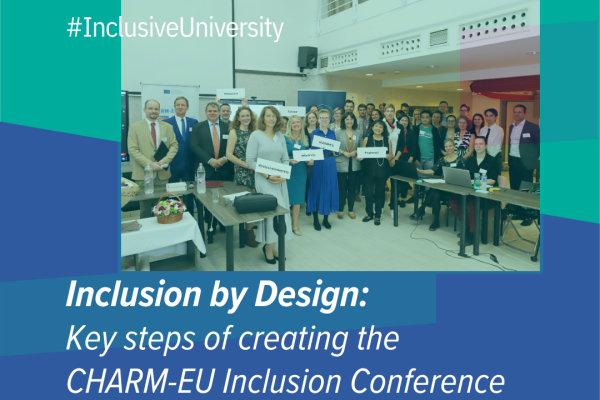A case study of the design and implementation of the first CHARM-EU Inclusion Conference has been published in the latest issue of the AHEAD Journal. Written by CHARM-EU Inclusion Team Leader Dr. Agnes Sarolta Fazekas-Vinkovits, the article demonstrates the key aspects to be considered when organising an inclusive event.

On 16 September 2022, Eötvös Loránd University hosted the first CHARM-EU Inclusion Conference titled “Creating an Inclusive University – Access and Participation in European Higher Education: Challenges and Enablers”. The pioneering event offered a unique opportunity to draw out lessons learned, consider barriers and possibilities as well as share experiences, policies and practices that can lead towards a more inclusive higher education sector. As Commissioner Mariya Gabriel highlighted in her addressed to the participants “Inclusion is crucial to the development of Europe’s higher education institutions and European society at large.”
The design, delivery and evaluation of the Conference followed the Universal Design Approach considering as many aspects as possible for creating an event that is accessible to the greatest number of participants. In her article titled “Inclusion by Design: Key steps of creating the CHARM-EU Inclusion Conference”, Dr. Fazekas-Vinkovits, assistant professor at ELTE’s Bárczi Gusztáv Faculty of Special Needs Education and CHARM-EU Inclusion Team leader reflects on the importance of Universal Design, presents best practices and explains how step-by-step inclusion in action can lead to the design and delivery of inclusive events.
The Universal Design Approach of the CHARM-EU Inclusion Conference
Based on the definition of UNCRPD, Universal Design refers to a design of products, environments, programmes and services that are usable by the greatest extent of people without the need for adaptation. This approach is fundamentally proactive: instead of “fixing” the environment later in a retrospective way, Universal Design Models facilitate a holistic approach to create inclusive environments from the very first phase of the design process.
In line with the principles and values of CHARM-EU and the European Union, the conference celebrated diversity, inclusion, equality, human rights, and intersectionality. The main purpose of the event was to act as a catalyst for a shared dialogue between stakeholders and participants to discuss enablers and challenges to access and participation and to identify next steps to facilitate a more inclusive higher education sector. The hybrid event brought together people from diverse backgrounds and cultures from Europe and beyond.
The comprehensive first panel focused on co-creation, co-operation, co-management, and co-research encompassing individuals with various lived experiences, backgrounds, and access needs and their active listening and participation as key enablers of a forward-looking dialogue. The second session included two panel discussions with students and educators sharing personal experiences and discussing areas of further improvement. The afternoon workshop provided space and time for small group work on envisioning the inclusive university of the future and was followed by a session dedicated for sharing visions, policies and practices.
Inclusive Event Design by the CHARM-EU Inclusiveness Team
The article demonstrates how step-by-step inclusion in action can support organisations, stakeholders, and individuals in designing, delivering, and evaluating inclusive events or activities using the CHARM-EU Inclusion Conference as a case study and focusing on areas such as communication and dissemination, community engagement as well as the ingredients necessary for creating a welcoming and inclusive atmosphere.
Regarding communication and engagement, measures included – among others – accessible and pre-reviewed registration formats, inclusive communication campaign, the promotion of inclusive language and the choice of a user friendly and accessible online platform. In terms of access and participation, the accessibility and layout of the venue was carefully considered with a special focus on dismantling physical barriers, providing Speech-to-text Service Provision as well as a neutral, multifunctional quiet space. Particular attention was paid to catering and dietary requirements, privacy and off-camera locations as well as respecting break times – an access need for all. Aligning with CHARM-EU Core Values, organisers were also conscious of the environment with reducing unnecessary equipment and printing, optimising access and participation needs, financial aspects, and suggesting greener travel options.
The organisation process and findings of the CHARM-EU Inclusion Conference may benefit various stakeholders choosing to apply the highlighted design elements within their organisations and events. To facilitate the organisation of inclusive events, the CHARM-EU Inclusiveness Team has prepared an open tool for the community and beyond which is available via this link: Tips for creating more inclusive CHARM-EU events
You can read the open access article and learn more about inclusive event design here.
Reference
Fazekas-Vinkovits, A. S. (2023): Inclusion by Design: Key steps of creating the CHARM-EU Inclusion Conference. The AHEAD Journal, Issue 16. https://ahead.ie/journal/Inclusion-by-Design-Key-steps-of-creating-the-CHARM-EU-Inclusion-Conference